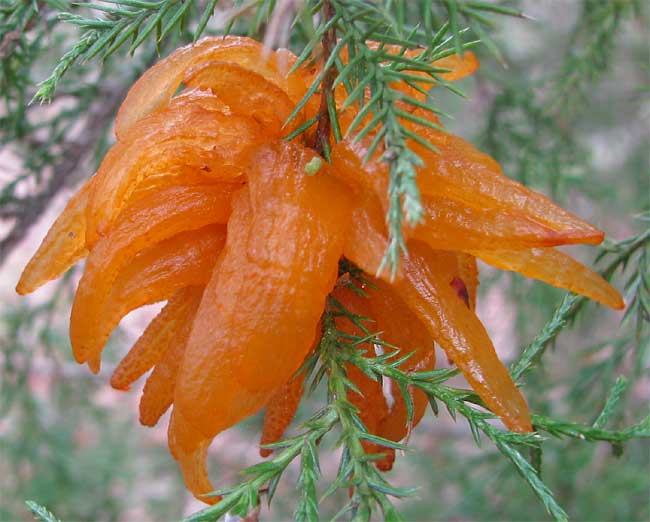Excerpts from Jim Conrad's
Naturalist Newsletter

from the March 23, 2009 Newsletter, issued from the forest near Natchez, Mississippi; elevation ~400ft (120m), ~N31.47°, ~W91.29°:
CEDAR-APPLE RUST
A couple of weekends ago we had several days of showers and storms, which much encouraged the Kingdom of the Fungi. One of the most interesting fungi to appear soon after the rains ended was GYMNOSPORANGIUM JUNIPERI-VIRGINIANAE, Cedar-Apple Rust. Its picture is above.
At least, that picture shows one of Cedar-Apple Rust's manifestations. This fungus has a complex life history and what you're seeing is the way it looks growing on a stem of Eastern Redcedar, Juniperus virginiana. Here's the rest of the story:
Cedar-Apple Rust alternates between Eastern Red Cedar and, usually, apple and crabapple. After spring rains the bright orange, gelatinous masses of spores shown in the photograph (technically known as telial horns) emerge from hard, spherical stem galls where the fungus has overwintered. When dry weather comes a few days later the masses disintegrate into loose spores (special spores known as teliospores) that wind blows onto apple and crabapple trees whose stems and leaves are just emerging from buds.
Inside growing apple and crabapple leaves two strains of the fungus mate and produce structures on the lower leaf surface from which a new spore form is realeased. These spores are then blown back to redcedars in mid summer to fall, develop galls on a redcedar that mature over a period of about 17 months, and then after spring rains the next year the whole cycle begins again. Wind can easily spread spores between redcedars and apple and crabapples for distances of several hundred yards, and if a spore is particularly lucky, even miles away.